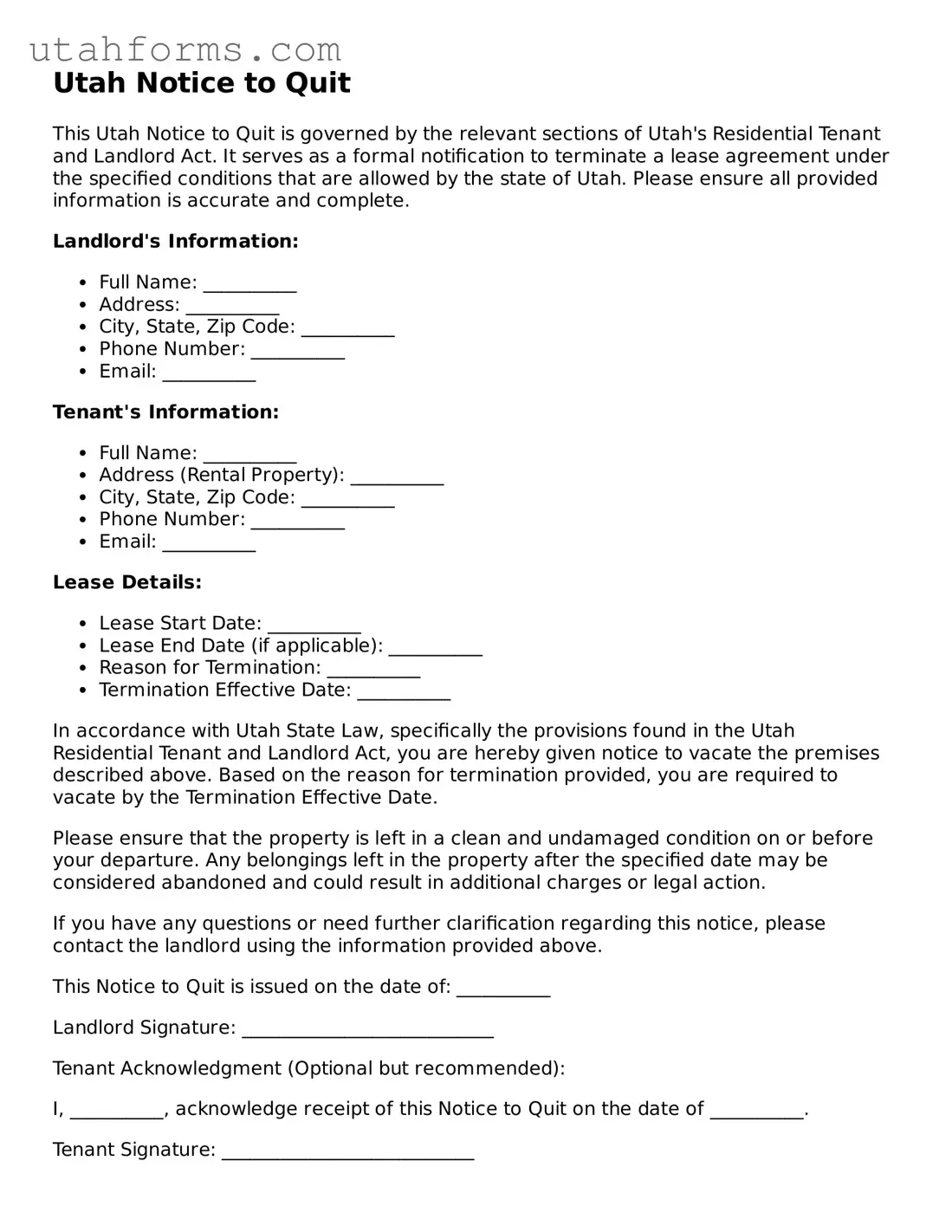The Utah Notice to Quit form shares similarities with an Eviction Notice that landlords use to initiate the process of removing a tenant from a property. Like the Notice to Quit, the Eviction Notice notifies the tenant of the landlord's intention to terminate the rental agreement due to violations, such as unpaid rent or other breaches of the lease. Both documents serve as a formal step in enforcing real estate and tenancy laws, outlining the reasons for termination and the conditions under which the tenant must vacate the premises.
Comparable to the Utah Notice to Quit is the Lease Termination Letter. This document is used by either the landlord or the tenant to formally announce the end of a lease agreement before the specified contract end date. Similarities include providing notice within a specified timeframe and detailing the reason for termination, though the context can be broader than violation-based scenarios, encompassing various lawful reasons for early lease termination.
The Pay or Quit Notice closely parallels the Utah Notice to Quit, especially in contexts where the reason for eviction is unpaid rent. This document specifically requires the tenant to either pay the outstanding rent within a given period or vacate the rented property. Both documents aim to provide clear and legally binding communication between landlords and tenants concerning the consequences of lease agreement breaches.
The Cure or Quit Notice is another document similar to the Utah Notice to Quit but is focused on violation scenarios aside from non-payment of rent. This notice gives the tenant a chance to "cure" (correct) the violation, such as unauthorized pets or guests, within a specified timeframe, or otherwise "quit" (leave) the property. It embodies the legal principle of offering a remedy to rectify a situation before escalating to eviction.
The Notice of Lease Violation also relates closely to the Notice to Quit. It is usually the first step in the eviction process, alerting tenants to specific lease violations. Unlike the Notice to Quit that demands vacating the property, the Notice of Lease Violation often serves as a warning, allowing tenants an opportunity to fix the issue. It's a precursor document that can lead to a Notice to Quit if the tenant fails to comply.
Similar in intent, the 30-Day Notice to Vacate is used by landlords and tenants to announce the termination of their lease agreement, typically at its natural conclusion or for month-to-month leases. This document, like the Utah Notice to Quit, provides a clear timeline for vacating the property but is used in less contentious circumstances, without necessitating the resolution of lease violations.
The Unconditional Quit Notice, while similar, is more severe than the Utah Notice to Quit. This notice demands that the tenant leave the property without an option to remedy any lease violation. It's typically reserved for serious violations and repeated offenses. Both documents indicate termination of the lease but vary in the tenant’s ability to rectify the situation.
A Notice of Termination is broadly akin to the Utah Notice to Quit, as it formally notifies the party (tenant or landlord) of the intention to end the lease agreement. It can be used in various scenarios, including lease violations or the end of a fixed-term lease. The specificity of reasons and conditions in this document can mirror those in a Notice to Quit, emphasizing its legal weight in terminating housing agreements.
The Notice of Rent Increase is indirectly related to the Utah Notice to Quit because it communicates changes in the terms of tenancy, specifically regarding rent payments. Though its primary function is not to terminate the lease but to adjust its financial terms, failure to comply with the new terms could lead to a Notice to Quit due to non-payment, highlighting a legal avenue for lease modification and potential termination.
Lastly, the 3-Day Notice to Pay or Quit represents a specific type of eviction notice more immediate than the general Utah Notice to Quit. It is applied in urgent cases of non-payment, requiring the tenant to pay the overdue rent within three days or vacate the property. While it is a more expedited process, it shares the foundational legal principle with the Notice to Quit, which is to provide a form of communication about lease violations that may result in eviction.
